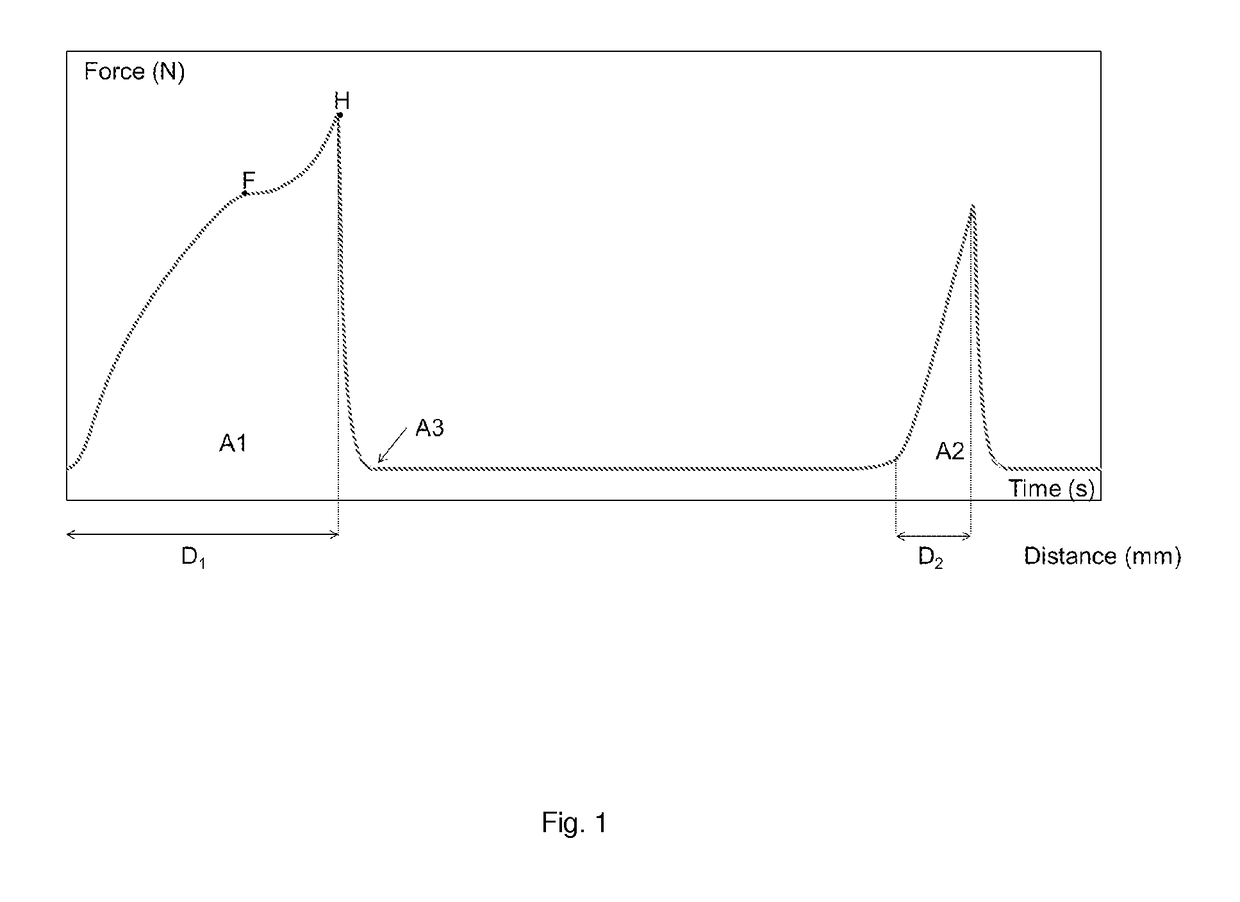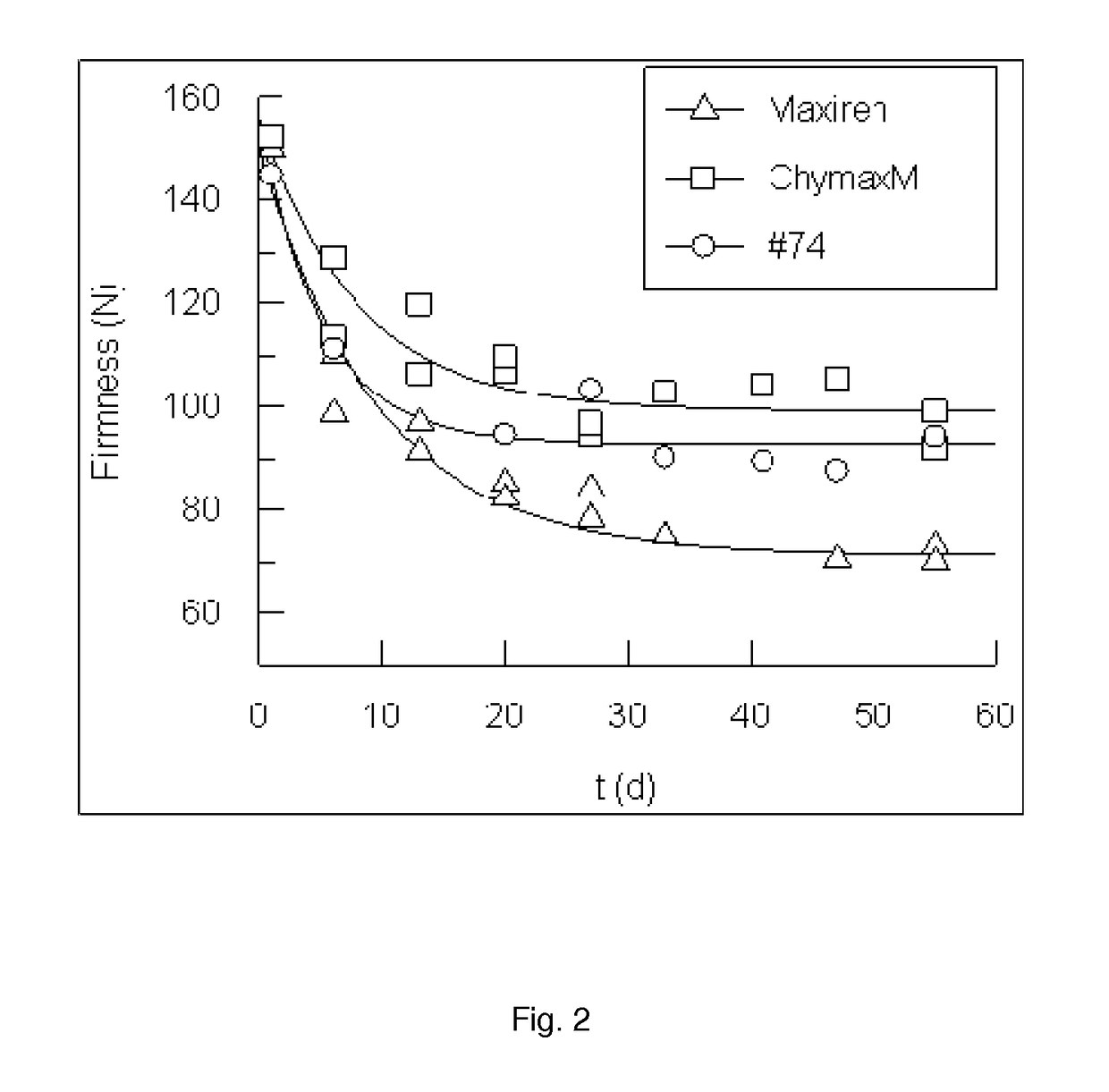Modified chymosin polypeptides
a polypeptide and chymosin technology, applied in the field of polypeptides with modified chymosin activity, can solve the problems of clogging the cheese shredder, excessive matting of the cheese shreds, and shredded cheese may also produce shreds with ragged edges, etc., to achieve fast early development in ripening, prolong the storage of cheese, and high c/p value
- Summary
- Abstract
- Description
- Claims
- Application Information
AI Technical Summary
Benefits of technology
Problems solved by technology
Method used
Image
Examples
example 1
ructs and Transformation
[0223]Synthetic DNA constructs were designed to start with a XhoI restriction site, encoding amino acids L and E, followed in frame with DNA encoding a kex-protease cleavage site with amino acids K and R, followed by in frame genes encoding variants of bovine pro-chymosin B starting with amino acids A, E, I and T, ending with a PacI restriction site just after the stop codon. As an example, a DNA fragment encoding the wild type bovine pro-chymosin B sequence is listed as SEQ ID NO: 1 and a DNA fragment encoding the wild type camel pro-chymosin sequence is listed as SEQ ID NO: 3. Codon usage was adapted according to the method described in patent application US090286280. All variants were designed in a similar fashion and cloned as XhoI PacI fragments in vector pKLAC1 (New England Biolabs, Ipswich, Mass., USA).
[0224]The resulting open reading frames start with the leader sequence of the K. lactis Mating Factor alpha and progresses over the kex processing site ...
example 2
on, Activation and Concentration
[0227]The Kluyveromyces lactis strains harbouring a mutant bovine pro-chymosin gene were placed on YEP2D agar plate and grown for 48 hours at 30° C. A pre-culture in 20 ml of YEP2D medium in 100 ml Erlenmeyer flasks was inoculated with the yeast cells taken from the plates. The cultures were grown for 24 hours in an incubator shaker at 30° C. and 250 rpm. The amount of pre-culture for inoculation of new 500 ml Erlenmeyer flasks with 100 ml YEP2D / MES medium was calculated to give a final OD600=0.01. These main cultures were grown for 65 hours in an incubator shaker at 30° C. and 250 rpm. For strain conservation 2 ml of pre-culture were centrifuged (4000 rpm and 10 min), cell pellet was suspended in 0.7 ml 70% glycerol and stored at −60° C.
[0228]Pro-chymosin was converted (activated) into mature chymosin by a pH step as described below. 35 g of the broth of the main culture after 65 hours cultivation was centrifuged at 8000 rpm for 15 minutes (10° C.) a...
example 3
Determination
[0230]The specificity of chymosin (C / P) is an important parameter for the functional properties of the enzyme in the cheese making process. The specificity of an individual chymosin sample can be calculated by dividing the milk clotting activity (C) by the general proteolytic activity (P). In the experiments described here the relative C / P is being used. For this the C / P calculated for a specific variant is divided by the C / P calculated for Maxiren 1800. The relative C / P for Maxiren 1800 is set at 1.0.
[0231]As can be seen in Table 2, when variants with mutations at position A51 and / or K221 were tested this way, all show a higher relative C / P ratio than Maxiren. Variants 1-7 all have mutations at position A51 and / or K221 of the mature calf chymosin B. Although the single mutants 1, 5, 6, and 7 give a relatively modest increase in C / P, surprisingly the combination of mutations at positions A51 and K221 (variants 71, 74, 98, 103 and 110) give a synergistic effect on the in...
PUM
| Property | Measurement | Unit |
|---|---|---|
| pH | aaaaa | aaaaa |
| pH | aaaaa | aaaaa |
| volume | aaaaa | aaaaa |
Abstract
Description
Claims
Application Information
 Login to View More
Login to View More - R&D
- Intellectual Property
- Life Sciences
- Materials
- Tech Scout
- Unparalleled Data Quality
- Higher Quality Content
- 60% Fewer Hallucinations
Browse by: Latest US Patents, China's latest patents, Technical Efficacy Thesaurus, Application Domain, Technology Topic, Popular Technical Reports.
© 2025 PatSnap. All rights reserved.Legal|Privacy policy|Modern Slavery Act Transparency Statement|Sitemap|About US| Contact US: help@patsnap.com


